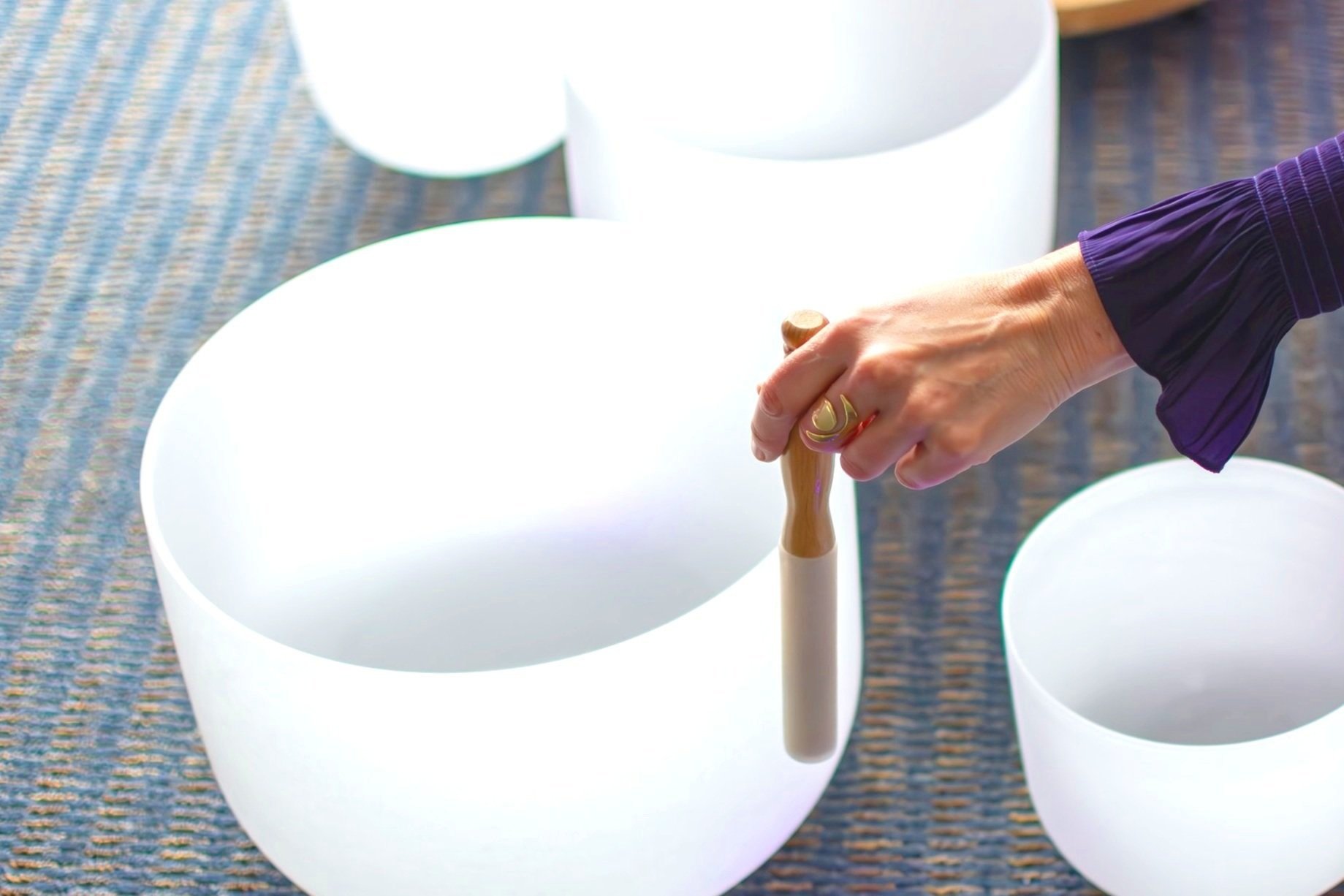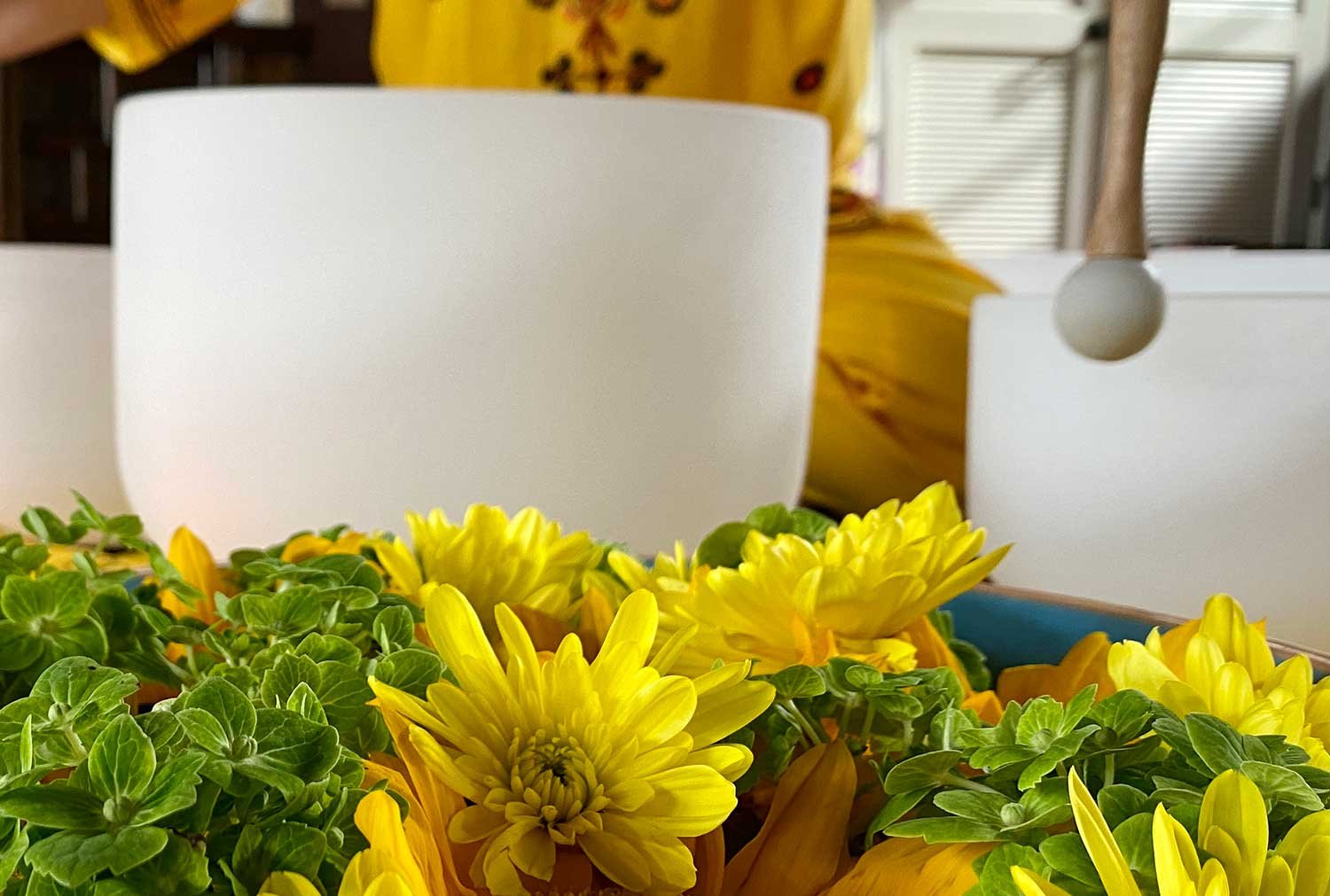
Training Resources
This overview of sound healing instruments, books, and recordings is intended to support your sound healing training.
You’ll find descriptions of my main instruments, along with useful links and discounts, plus a section with tips for purchasing singing bowls. I have also included some recordings with reference to my techniques for you to study and incorporate in your own practice.

Guide to Sound Healing Instruments
Koshi Chimes
Delicate fairy-like chimes made at the base of the Pyrenees, these Koshi chimes come in four different tunings and you can buy the entire set if you like. I mostly use “Ignis,” paired with a G-D drone.
Quartz and Metal Singing Bowls
My go-to distributors are Soundtopia and the OmShoppe. Both have excellent customer service and quality bowls that will be in tune. For frosted singing bowls I order “440 perfect pitch” bowls. You can also purchase “perfect pitch 432” but don’t mix and match tunings or they will not harmonize properly.
Purchasing them as a 7- or 8- note set (aka chakra set) ensures that they are sized to nest within each other for storage. If you purchase individual bowls, allow a 2-inch difference for safe nesting.
Metal or “Himalayan” bowls have richer, more complex overtones and prices vary greatly. Call and talk to a rep for advice, and don’t be afraid to ask them to send you a video of them playing your set of bowls. Both shops have good customer service.
Mallets
For tapping, you’ll get the richest sound from the Meinl Sonic Energy Gong friction mallet. Otherwise, for tapping/droning I use the white rubber ball mallets from OmShoppe. They have the best grip and least amount of surface noise.
Discounts
OmShoppe: Use code MoniqueMead15 for 15% off regular-priced items plus free shipping over $99.
Silver Sky Imports: Use code mead15 for 15% off.
Tingsha Cymbals
Two small, high-pitched cymbals on a string used in Tibetan prayer rituals, Tingsha should be made of 7 metals and on the heavier side for best quality and most resonance. Warning: always hold these away from crystal bowls: if the chimes fall, the bowl can break.
Ocean Drum
I use a 22-inch Remo drum. (They also have a 16-inch drum, but the sound is not as deep and rich.) Use a frame drum bag to protect it on the road. I recommend a blanket or cover to mute it. Here’s a sewing pattern for the cover I have.
Carrying Cases
These 14-inch carrying cases for singing bowls are the best deal I have found and can actually fit up to a 15-inch bowl, which means you can nest 3 more bowls within it. Be sure that the bowls you nest have a 2-inch difference in size and be sure to cushion them on all sides with a towel or blanket. I usually put the O-ring inside its corresponding bowl for added safety.
Yogibo Beanbag Loungers
There’s nothing that equals the comfort of a Yogibo. I use Yogibo Max $300. Note: Cleaning Yogibo covers takes some effort, so if yours will be in a high-traffic location, consider using an outdoor cover for it.
Lighting
After experimenting with lighting my bowls, I have landed on these rechargeable puck lights, which you can place directly in the bowls with a rubber gripper underneath to minimize sound interference and slipping.
Aromatherapy
I use equal parts lavender and eucalyptus oil in any diffuser for a lovely scent that is both calming and clearing.

Tips for purchasing singing bowls
Start with a tone that resonates with you
Once you select your preferred tone, build your set around that by selecting neighboring tones from this sequence: B - E - A - D - G - C - F. (If you purchase a D, your next bowl would be an A then a G.)
Of course, you can purchase a full “chakra set,” but there’s also a lot you can do with a pentatonic set (C, D, F, G, A), which will sound good together and offers plenty of musical possibilities. With just 5 bowls combined with an ocean drum, 1 Koshi chime and a Tingsha chime you can orchestrate an entire sound bath.
A standard set is “4th octave”
These are typically 8 - 14 inches. If you’re buying multiple bowls, be sure they have a 2-inch difference so that they can nest within each other, should you want to store them or take them on the road. When you buy an entire set of bowls, they’ll already be selected so that they nest within the 2 largest bowls.
Low frequency notes are “3rd octave"
This means that from the bottom of the piano, these notes are 3 octaves up (or one octave below middle C). These are the bowls that are the most grounding and that you feel more in your lower body. They emit palpable frequencies, and they have to be large. For 3rd octave bowls, be sure the lowest ones (C, D, E, F) are at least 16-22 inches and higher ones (G, A, B) are 18-15 inches. Magic happens when you play bows in octaves (a 3rd octave G with a 4th octave G, for example.)
Mallets for Quartz Bowls
When you order your bowls, they’ll often come with a suede mallet. Let the company know you’d like silicone instead and they may upgrade you to a silicone ball mallet or straight mallet.
This high-quality rubber (ball) striker is my current favorite for tapping and droning, since you can use it at the rim as well as lower down on the bowls to achieve different sounds. Droning with it lower on the bowl prevents unpleasant rim feedback you would get when droning with a straight mallet on the rim. For the richest tapping sound, I use a gong friction mallet which bounces back nicely and absobs some of the percussiveness of the attack. You can also use straight silicone mallets for droning and tapping on the rim of the bowl.
Recommended Reading
-

Dr. Mitchell Gaynor, MD
-

Sara Auster, NYC Practitioner
-

Goldman/Sims
-

Miller & Cutshall
-

David Hawkins, MD, PhD
Power vs. Force and The Map of Consciousness Explained
-

Hazrat Inayat Kahn
Sufi philosopher and musicologist
-

The OMShoppe
-

Destination Deluxe
-

Forbes Magazine
A Psychologist Explores The Healing Power Of ‘Sound Baths’
-

John Beaulieu

Let music be your medicine.
Recorded Sound Meditations
As a Sound Healing trainee, you’ll recognize some of the techniques we practiced to steady and calm the mind. They’re outlined below:
Sonic Journey: a full sound bath with many of the elements you experience in my sessions
Grounded Belonging: repeated motifs in C Major to establish safety
Calm Focus Meditation: uses progressively slowing heartbeat motif to expand time. D minor creates inner focus.
Circle of Support Meditation: employs circle of 5ths for stability within a ring of support.
Sonic Slumber Meditation: uses the layered approach of melody, rhythm, and harmony with ocean drum, bowls, and koshi chimes















